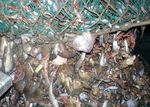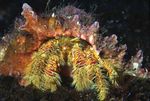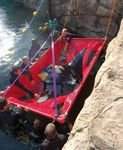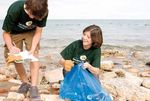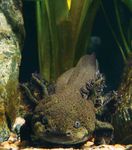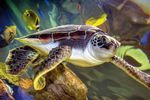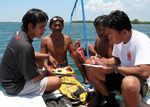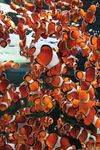WAZA Turning The Tide - A global Aquarium Strategy for Conservation and Sustainability
←
→
Page content transcription
If your browser does not render page correctly, please read the page content below
WAZA
Turning The Tide
A global Aquarium Strategy for
Conservation and Sustainability
Executive Office
This publication was produced with financial support from the North of England Zoological Societyi
Turning The Tide
A global Aquarium Strategy for
Conservation and Sustainability
Implementation of the World Zoo and
Aquarium Conservation Strategy by the
WAZA Aquarium Community and Partners
Compiled and edited by
M. Penning, G. McG. Reid, H. Koldewey, G. Dick, B. Andrews, K. Arai, P. Garratt,
S. Gendron, J. Lange, K. Tanner, S. Tonge, P. Van den Sande, D. Warmolts and C. Gibsonii TurninG The Tide A Global Aquarium Strategy for Conservation and Sustainability
Citation
Penning, M., Reid, G. McG., Koldewey, H., Dick, G., Andrews, B., Arai, K., Garratt, P., Gendron, S., Lange, J., Tanner, K.,
Tonge, S., Van den Sande, P., Warmolts, D. and Gibson, C. (Eds) 2009. Turning the Tide: A Global Aquarium Strategy for
Conservation and Sustainability. World Association of Zoos and Aquariums, Bern, Switzerland.
ISBN 978-3-033-02140-2
© WAZA 2009
WAZA Executive Office design Cover
Lindenrain 3 www.naturebureau.co.uk Open ocean exhibit at Monterey
3012 Bern Bay Aquarium, USA, with
Switzerland Print great white shark. Back cover:
www.waza.org Hairy hermit crab, Anomura sp.
Information Press, Oxford, UK
© Dennis King, South Africa. High
School Lake Ecology Class, Shedd
Aquarium, USA.
The World Association of Zoos and Aquariums (WAZA) is a global organisation which harmonises the principles, policies,
practices and strategy of over 1300 leading zoos and aquariums. WAZA is the unifying representative of the global zoo and
aquarium community and works in partnership with IUCN, national governments and non-government organisations to
ensure high standards of animal welfare and to achieve conservation in zoos and aquariums (ex situ) and in nature (in situ).
(www.waza.org)iii
Contents
Foreword ..................................................................................................................................... v
international endorsement ....................................................................................................... vii
executive Summary ..................................................................................................................... x
introduction ................................................................................................................................. 1
The Strategy .............................................................................................................................. 11
1. Integrating Conservation ..................................................................................................... 12
2. Conservation of Wild Populations ........................................................................................ 14
3. Science and Research .......................................................................................................... 20
4. Population Management ..................................................................................................... 24
5. Education and Training ........................................................................................................29
6. Communication, Marketing and Public Relations................................................................. 34
7. Partnerships and Politics...................................................................................................... 36
8. Sustainability ......................................................................................................................40
9. Ethics and Animal Welfare ................................................................................................... 43
Acknowledgements ................................................................................................................... 50
references ................................................................................................................................. 51
Appendices
I Glossary............................................................................................................................ 56
II Institutions, organisations and programmes associated with aquariums and
aquatic conservation......................................................................................................... 62
III Public aquariums: the global scale of the industry ............................................................. 64
IV Public aquariums: strengths and challenges in support of conservation ............................ 67
V Public aquariums: global role in education ........................................................................69
VI Public aquariums: international conventions, codes and guidelines .................................. 70
VII Public aquariums: examples of in situ and ex situ conservation and education projects ......71
VIII Public aquariums: global list of breeding programmes ...................................................... 75
IX Public aquariums: selected serial publications on aquatic and wetlands research and
associated environmental aspects .................................................................................... 77v
Foreword
“There has long been a belief that the sea, at least, was
inviolate, beyond man’s ability to change and to despoil.
But this belief, unfortunately, has proved to be naïve”
Rachel Carson, The Sea Around Us 1951
The World Association of Zoos and Aquariums (WAZA) is a global organisation which acts to
harmonise the principles, practices, policies and strategy of over 1300 zoos and aquariums. Its
strap-line is ‘United for Conservation’. WAZA evolved from the International Union of Directors of
Zoological Gardens (IUDZG), founded in 1935 in Basle, Switzerland but which ceased to exist
during World War II. A reconstituted IUDZG was founded in Rotterdam in 1946 eventually to
become the World Zoo Organisation (WZO). In 2000, the WZO was re-named and re-branded as
‘WAZA’ to reflect a more modern and inclusive organisation, where public aquariums are fully
represented and where cooperative action is greatly valued and promoted. Today, WAZA is the
unifying representative and ‘voice’ for the global zoo and aquarium community. From its base in
Switzerland, it works in partnership with IUCN, national governments and non-government
organisations to ensure high standards of animal welfare and to achieve conservation and
sustainability both in zoos and aquariums (ex situ) and in nature (in situ).
WAZA’s vision is to be a trusted and leading partner in the conservation of biodiversity, with a
particular focus on species cared for by zoos and aquariums. Its mission is to provide leadership
and support for zoos, aquariums and partner organisations of the world in animal care and welfare,
conservation of biodiversity, environmental education and global sustainability. In the pursuit of
the vision and towards the fulfilment of the mission it was realised, almost 20 years ago, that a
strategic conservation ‘blueprint’ was required to guide the organisation and its members. From
this, in 1993, the World Zoo Conservation Strategy was published by the WZO-IUDZG in partnership
with the IUCN Species Survival Commission’s Conservation Breeding Specialist Group (CBSG). This
document defined for the first time the overall responsibilities and opportunities that the
international zoo and aquarium community needed to act on in order to be fully engaged in the
collective global conservation movement. In 2002, several senior representatives of the world zoo
and aquarium community met to discuss a proposed new strategy document: Dr Bert de Boer
(Chairman of the European Association of Zoos and Aquaria, EAZA, and principal author and editor
of the original 1993 strategy); Dr Ulysses Seal (then Chairman of the CBSG); Dr William Conway
(then Director of the Wildlife Conservation Society, New York, USA) and Professor Günther Nogge,
(then Director of the Cologne Zoo, Germany and a past President of the WZO). The new strategy
would build on the success of the original, begin to raise the profile of aquariums and also
demonstrate more ways in which zoos and aquariums could successfully support conservation
initiatives. From these initial excellent endeavours, a new strategy was developed under the aegis
of a Steering Committee, led by Dr Jonathan Gipps (Director of Bristol Zoological Gardens, UK, and
Chair of the WAZA Conservation and Sustainability Committee).
The new and current World Zoo and Aquarium Conservation Strategy (WZACS) was launched on the
2 May, 2005 in Melbourne, Australia. Headed ‘Building a Future for Wildlife’, it is the result of the
collective efforts of over 350 zoo and aquarium professionals and many other conservation and
sustainability partners worldwide. The strategy is aimed at all zoos and aquariums, associations
and partner organisations, however large or small, however rich or poor, and not just those who
are members of WAZA. The strategy provides a shared philosophy and high-level aspiration for
zoos and aquariums across the globe. It also defines the standards, policies and practices that are
necessary to achieve their goals in conservation. This landmark document can be downloaded
free-of-charge from the WAZA website at www.waza.org in English, German, Russian, Swedish,
Spanish, Portuguese, Polish, Czech and Chinese.vi TurninG The Tide A Global Aquarium Strategy for Conservation and Sustainability
Many internationally-respected individuals from public aquariums made significant contributions
to the original WZACS (2005) document. However, it has long been recognised that alongside
many aspects in common, there are differences between aquariums and zoos: in their nature,
character, typical constitution, operational requirements, in their stakeholder community; and in
the challenges faced in conservation and environmental sustainability for the aquatic or wetlands
environment. Hence, it was decided that a dedicated publication – prepared for and by aquarium
professionals and partners – was required to detail carefully the implementation of WZACS by
public aquariums. This new strategy document plots the course for public aquariums in a world
where marine, coastal and freshwater resources are being ruthlessly exploited, where water-
associated biodiversity is steadily declining and where the careful management of all aquatic
ecosystems is now crucial for the well-being of the planet. In short, this present document ‘Turning
the Tide’ is the full response of the WAZA Aquarium Community to the WZACS.
The implementation of this new strategy will be supported and monitored by WAZA through its
Aquarium Committee, with key inputs from the Conservation and Sustainability Committee, Ethics
and Welfare Committee, Science and Veterinary Committee, Marketing and Public Relations
Committee and its Education Committee (which is managed in close conjunction with the
International Zoo Educators, IZE). Through a cooperative, strategic approach, the aquariums of the
world will unite among themselves and with many other partners to make a meaningful
contribution to global efforts in aquatic conservation and sustainability.
Prof gordon Mcgregor reid dr Mark Penning dr Jonathan gipps OBe
WAZA President WAZA President Elect Chair: WAZA
Chair: Aquarium Committee Conservation and
Sustainability Committeevii international endorsement In preparing this document, we would like to warmly thank all of the WAZA institutional and regional association members together with numerous individual colleagues, including from the International Aquarium Forum (IAF), International Aquarium Congress (IAC) and European Union of Aquarium Curators (EUAC). A full list of individual acknowledgements is given (p. 50). WAZA is also most grateful for formal endorsement of this document by the IUCN Species Survival Commission, The Ramsar Convention on Wetlands, Conservation International, Wetlands International and the World Wildlife Fund-US. For their contributing reviews we thank: colleagues in the IUCN-Species Survival Commission – Dr Simon Stuart (Chair, IUCN-SSC) and Dr Will Darwall (Manager, IUCN-SSC Freshwater Biodiversity Unit); colleagues from the Ramsar Convention on Wetlands – Dr Anada Tiega (Secretary General) and his team; colleagues in Conservation International – Dr Russell Mittermeier (President), Dr Claude Gascon (Executive Vice-President, Programs and Science), Dr Tom Brooks (Vice-President, Conservation Priorities and Outreach, Center for Applied Biodiversity Science), Neil Cox (Programme Officer, IUCN SSC/CABS Biodiversity Assessment Unit) and Dr Ian Harrison (Freshwater Species Assessment and Program Fundraising Manager and Research Associate of the American Museum of Natural History, New York); colleagues in World Wildlife Fund-US – Dr Bill Fox (Head of Fisheries) and Dr Michele Thieme (Freshwater Fish Biologist); and colleagues in Wetlands International – Dr Jane Madgwick (CEO) and her team. WAZA also greatly appreciates the following statements of endorsement: international union for Conservation of nature One of the most exciting developments in conservation in recent years is the enormous growth in conservation activities, both in situ and ex situ, by the world’s zoos. In many senses this is a direct result of the World Zoo and Aquarium Conservation Strategy, which was spearheaded by the World Association of Zoos and Aquariums (WAZA) in 2005. I am now delighted to see, and endorse, the WAZA Global Aquarium Strategy for Conservation and Sustainability, and I am convinced that this will have an enormous impact in galvanizing the world’s aquariums for conservation. This strategy could hardly come at a better time. The world’s oceans are suffering from unprecedented impacts from humans, and conservation efforts need to be greatly strengthened. The potential loss of an entire ecosystem, coral reefs, as a result of increasing ocean surface temperatures and ocean acidification is now a very real possibility. Ensuring the survival of coral reefs is perhaps the greatest conservation challenge of our times. Failure will have very severe implications in terms of potential species’ extinctions, loss of livelihoods for those human communities dependent on reef-associated fisheries, and decreased coastline protection with the risk of catastrophic floods. The WAZA Global Aquarium Strategy for Conservation and Sustainability is an important part of the global response to this challenge, and I congratulate WAZA on showing the vision and leadership to bring this about. Simon n. Stuart, Phd Chair, Species Survival Commission International Union for Conservation of Nature
viii TurninG The Tide A Global Aquarium Strategy for Conservation and Sustainability
Conservation international
The World Association of Zoos and Aquariums has developed an important strategy describing the
essential role that aquariums can play in furthering the conservation of aquatic species. The
strategy identifies the direct contributions that can be made through the implementation of in situ
and ex situ conservation programmes. The strategy also highlights the contribution that aquariums
can play in professional capacity development and public education, to ensure a better
understanding of aquatic ecosystems, their conservation and the services that these ecosystems
provide to human well-being. Through the implementation of this strategy, aquariums can inspire
and help societies to manage aquatic assets sustainably for the equitable benefit of current and
future generations.
Conservation International believes that the conservation of aquatic biodiversity is closely linked to
safeguarding the livelihoods of the billions of people who rely on the services provided by these
ecosystems. These include the provision of clean freshwater, the food resources from the Earth’s
seas, lakes, rivers and other wetlands, and the myriad of other environmental, cultural, and
aesthetic services provided by these aquatic ecosystems. CI is working with many other partners,
including IUCN’s Species Programme and Species Survival Commission, Wetlands International
and NatureServe, to create global priorities that integrate aquatic biodiversity, ecosystem services
and human well-being. These include the Global Marine Species Assessment and Global Amphibian
Assessment programmes that provide much of the global data on threats to aquatic species and
their conservation status. These data, recorded in IUCN’s Red List of Threatened Species TM,
underpin many of the programmatic activities recommended in this WAZA Global Aquarium
Strategy for Conservation and Sustainability.
This WAZA Aquarium Strategy also identifies several opportunities for collaboration with research
institutions, national and international non-governmental organisations, and local organisations,
all of which share the goals of conserved and sustainable aquatic ecosystems.
Therefore, Conservation International congratulates the World Association of Zoos and Aquariums
on the development of this very important document and looks forward to the opportunities to
contribute to the success of the Strategy.
russell. A. Mittermeier, Phd
President, Conservation Internationalinternational endorsement ix Wetlands international Our congratulations to the World Association of Zoos and Aquariums for issuing A Global Aquarium Strategy for Conservation and Sustainability. Wetlands International has been working worldwide for almost two decades towards the sustainable use of wetlands, including the full range of their services benefiting biodiversity and human well-being. Representing 6% of the land surface, 30% of all freshwater, 40% of all species and with over one billion people directly depending on them, wetlands remain a priority for conservation and development. Furthermore, the close links between IUCN SSC / WI Specialist Groups and the WAZA community – particularly through the Freshwater Fish Specialist Group – illustrates our shared objectives. We therefore greatly appreciate WAZA targeting its strategy towards conservation and sustainability and hope to further increase our collaboration in the future for the sustainable use of wetlands. This publication will certainly catalyse and strengthen ties between zoos, aquariums and the International Conservation Community. I would like to thank you for this opportunity, Jane Madgwick, Phd CEO, Wetlands International ramsar Convention on Wetlands The Ramsar Convention on Wetlands congratulates the world’s aquarium community for having elaborated the WAZA Global Aquarium Strategy for Conservation and Sustainability. This strategy clearly recognises and defines the substantial and concrete roles that aquariums can and should play to contribute to the global challenge of achieving a significant reduction of the current rate of biodiversity loss, including in regard to wetland ecosystems such as freshwater rivers, swamps, ponds and lakes, coastal lagoons, deltas, estuaries and mangroves, seagrass beds and coral reefs. Aquariums are particularly well suited to make the wider public aware of ongoing wetland loss, species decline and the need to counteract this through conservation and restoration of these ecosystems. Aquariums also have a great educational potential. Threatened wetland species are excellent communication tools to create a better understanding of complex ecological processes and to obtain public participation and engagement in conservation projects. The Ramsar Convention looks forward to working together with WAZA and the world’s public aquariums to this end. Anada Tiega, Phd Secretary General, Ramsar Convention on Wetlands
10
x TurninG The Tide A Global Aquarium Strategy for Conservation and Sustainability
executive Summary
There are well in excess of 300 substantial public aquariums in the world and more than 100 have
been opened since 1990. Collectively, including those operated within zoos, they may attract as
many as 450 million visitors each year; and so have a very large educational and economic impact.
This rapidly growing ‘Aquarium Industry’ (ranging from commercial businesses through to, municipal
institutions, research establishments and charitable trusts) is often associated with economic
regeneration projects to revive socially impoverished, run down docklands and industrial areas.
Public aquariums are also actively engaged in a large, diverse and ever-expanding programme of
conservation and sustainability initiatives from conservation breeding through to the restoration
and re-stocking of natural marine and freshwater habitats. Their agenda covers everything from
mountain streams, swamps, peatlands and coastal wetlands to the ocean depths; coral reefs to
cave fishes and otters; crabs and clams to crocodiles and hippos; jellyfish to penguins, snakes, sea
lions and dolphins; and sharks to seahorses, salamanders, frogs and turtles. Public aquariums in
partnership with other organisations have a massive potential to tackle global issues in conserving
aquatic biodiversity and water resources, alongside issues in fisheries, environmental management,
aquatic animal welfare, human development and poverty alleviation.
Turning the Tide: A Global Aquarium Strategy for Conservation and Sustainability (WAZA, 2009) is the
detailed response of the international aquarium community to the, more general, World Zoo and
Aquarium Conservation Strategy published by the World Association of Zoos and Aquariums (WAZA,
2005). The structure of Turning the Tide follows chapter sequence and headline statements made in
the original WZACS. Topics covered are: Integrating Conservation; Conservation of Wild
Populations; Science and Research; Population Management; Education and Training;
Communication, Marketing and Public Relations; Partnerships and Politics; Sustainability; Ethics
and Animal Welfare.
The world’s aquarium community have provided detailed responses to the original statements,
emphasising the close, intricate, sophisticated and vital relationship between conservation work
conducted off-site (ex situ) with that implemented in nature (in situ). There follows, per chapter
section, action lists that could or should be adopted at different levels ranging from individual
public aquariums through to national and regional aquarium/zoo associations.
Public aquariums, national and regional associations and partners are encouraged to maximise the
conservation, sustainability, educational and scientific value of their activities, carefully taking into
account the recommended responses and action lists in Turning the Tide. In doing so, they should
develop their own customised, written aquarium action plans, incorporating ‘SMART’ objectives.
This means setting conservation, sustainability and other targets that are Specific, Measurable,
Achievable, Realistic and Time-bound.1
introduction
The aquarium ‘industry’
It is difficult to make absolute distinctions as to what constitutes
Zoo
a ‘zoo’ versus a ‘public aquarium’, as most will include terrestrial,
mammals
aquatic, amphibious and highly water-dependent species in
their collections, albeit usually in different taxonomic
birds
proportions (Figure 1). The free-standing public aquariums of
the world and zoo-aquariums may be charities, municipal reptiles and
amphibians
facilities, university research institutions or commercial
enterprises. However constituted, they are uniquely placed to fishes
communicate with a large proportion of the global population
invertebrates
and to foster in their visitors an appreciation of the aquatic
environment. At least 650 million people visit zoos and Aquarium
aquariums each year worldwide, making this a bigger mass
public participation activity than football (soccer)! Figure 1. Typical differences between zoos and aquariums in
taxonomic representation. Reid, G. McG., 2004.
The total number of substantial public aquariums in the world is
estimated to be well in excess of 315 (Appendix III) with the
number (WAZA affiliated and non-affiliated) increasing each
year. Since the early 1990s more than 100 public aquariums
have been opened around the world, notably including 22 in Chester Zoo’s conservation-themed aquarium. © Steve Rawlins.
China (Appendix III). This contrasts with the far slower rate of
establishment of entirely new terrestrial zoos. This remarkable
contemporary expansion of the ‘aquarium leisure industry’
reflects public enthusiasms and demands and is also often
associated with the multi-million dollar regeneration of cities,
docklands and other run-down, previously industrial areas.
Such large-scale investments bring about highly beneficial
economic, employment and social impacts.
The existence and rapid spread of aquariums in all regions of
the world also creates new educational opportunities across a
diverse and multi-cultural audience representing all socio-
economic categories. Through innovative and informative
educational displays, these institutions work to inspire people
to care about the state of our aquatic environment, and to
empower them to make lifestyle choices that are environment-
friendly. The potential is enormous. At least 250 million people visit an aquarium each year
(Appendix III). If China is included then (on current approximate data) the figure could be as high
as 450 million. Individual large public aquariums in China, Japan, and the USA achieve in excess of
3, 4, 5 or 6 million visits each year (Appendix III).
As well as having a strong economic, visitor and education base, public aquariums have numerous
other strengths (Appendix IV) and are now rising to the many substantial challenges in conserving
the natural aquatic environment and demonstrating ‘sustainable credentials’. Often still
dependent on wild-caught stock for exhibits (in a way that modern terrestrial zoos generally are
not) public aquariums are responding by becoming increasingly engaged in collaborative,
international conservation breeding programmes (e.g. Species Survival Plans and Taxon Advisory
Groups). These involve many threatened aquatic species of mammals, birds, reptiles, amphibians,
fishes, invertebrates and plants (Appendix VIII). Aquarium-bred populations serve as an ‘insurance
policy’ providing conservation options for re-introduction in the event of threatened taxa
becoming extinct in the wild (EW) under IUCN Red List criteria. Increasingly, aquariums also fund
and engage in conservation and sustainability projects in the field at home and abroad, and often
in partnership with other conservation organisations (Appendix VII).2 TurninG The Tide: A Global Aquarium Strategy for Conservation and Sustainability
Oceania. © Wetlands International.
Planet ‘Water’
Perhaps all of us at times underestimate the extraordinary power
and importance of water and the value of life that lives in and
around it. Our planet that we know as ‘Earth’ could just as easily
be named ‘Water’, with over 1.36 billion cubic kilometres of fluid
taking up some 70.8% of the planet’s surface. Of this water,
97.2% exists in the oceans, 1.8% in glaciers, ice caps and ice
sheets, 0.9% in groundwater and 0.02% in freshwater in lakes,
inland seas, and rivers. One thousandth of a percent is
atmospheric water vapour at any given time, including from the
air that humans and other terrestrial animals breathe out. Water
flows in our veins and is, literally and metaphorically, our ‘life
blood’ and few fully recognise the crucial wider role that water
plays in making our planet suitable for human and all other life.
Life on Earth is only possible because of the oceans, rivers and
water bodies inland. Approximately 70% of the oxygen we
breathe is generated by floating ‘algae’ (phytoplankton) in the
world’s oceans and lakes, with just 30% being produced by the
forests and other plant biomes on land.
The Earth’s climate is driven by the ocean currents, which carry heat around the planet, and dictate
the weather and basic environmental conditions for life. Recent research indicates that the little
understood but fundamental phenomenon of electro-magnetism may relate, at least in part, to
global water movements. Scientific studies on global warming indicate that we could have a
virtually ice-free Arctic within 30 years, with consequent continental floods that would negatively
affect up to one-quarter of the world’s population and countless species of animals and plants
(http://www.agu.org/pubs/crossref/2009/2009GL037820.shtml).
Aquatic biodiversity and water resources
Water bodies support an astonishing diversity of natural organisms with, for example, some 70,000
mollusc, 40,000 crustacean, 29,300 fish and 5,743 amphibian species listed (http://www.iucnredlist.
org/static/stats), alongside a multitude of mammals, birds, reptiles, insects and aquatic species of
plants, both microscopic and macroscopic. With the discovery of species new to science, the
taxonomic list grows substantially each year. For freshwater, estuarine and marine fishes alone, more
than 300 new species have been described each year from 2006–2008 and close to 500 were
described in 2009 (IUCN SSC/WI Freshwater Fish Specialist Group database). It is estimated that
some 50–80% of the world’s biodiversity is found in the oceans (http://www.panda.org/about_our_
earth/teacher_resources/webfieldtrips/oceans_threat/; http://www.waza.org/marketing/
Indian River, Dominica. © Richard Gibson, Chester Zoo, UK.introduction 3
downloads/18%20Judy%20Mann%20-%20UsHAKA.pps). Nonetheless, humans spend far more
money contemplating other planets than in studying oceans and other still poorly understood
aquatic ecosystems!
All animals and plants rely heavily on water, with agriculture for crops being a notably big consumer,
accounting for as much as 70% of all freshwater use. In addition to daily freshwater intake needs,
water provides valuable opportunities for human hygiene, energy generation, recreation and for the
creation of economic livelihoods. Around 60% of the world’s population live within 60km of the sea,
but we fail to care as we should for such a valuable resource. More than 450 cubic kilometres of
waste are dumped into the sea each year, some of it highly toxic and not biodegradable.
Global fisheries and environmental issues
The majority of the world’s fisheries are food fisheries that provide roughly 40% of the protein
consumed by nearly two-thirds of the world’s population. Some 38 million people make all or a
major part of their living from fishing worldwide, landing about 90 million tonnes of fish per year.
This is transformed into numerous economic products both consumable and non-consumable,
including fresh fish meat, canned fish, dried fish, roe, caviar, oils, skins and ground meal. There is a
smaller allied trade in shells, dried corals, curios and traditional medicines derived from aquatic
species. Very many aquatic taxa ‘shellfish’ (invertebrate) ‘finfish’ (vertebrate) are involved in
mainstream fisheries (refer, for example, to FishBase http://www.fishbase.org/). In addition,
recreational fishing accounts for at least 4% of the world’s catch and has an overall value of around
US$ 16 billion per year.
Regrettably, these same world’s fisheries are in a state of crisis. The Food and Agriculture
Organization (FAO, http://www.fao.org/) currently estimates that 70% of commercial fisheries
have already collapsed or are over-fished and likely to collapse. Populations of many of the ‘top’
predatory fishes, such as certain species of tuna, swordfish and sharks have been reduced to 10%
of the original levels. Charismatic invertebrates such as octopus and cuttlefish are suffering too.
Each year some 30 million tonnes of sea life (including rare sharks, dolphins, turtles, seabirds,
seahorses and water snakes) are discarded as accidental ‘by-
catch’. Aquatic species of animals and plants at particular risk Seal tangled in fishing net. © Salkode Wolf – Ecomare.
through trading are increasingly being listed under CITES (The
Convention on International Trade in Endangered Species of Wild
Fauna and Flora, see Appendix I). The threats to wildlife and
sustainable global fisheries are many indeed, from over-fishing,
by-catch, destructive fishing techniques, global warming and
climate change, pollution (including shipping, land-based,
industrial, agricultural and pharmaceutical); and the relentless
degradation of the aquatic and coastal environment, notably
including mangroves and coral reefs.
Logging in Borneo. © Roland Seitre.4 TurninG The Tide: A Global Aquarium Strategy for Conservation and Sustainability
Living coral reefs and reef-associated species are, in particular, under threat from ocean acidification,
resulting from the steady global increase in dissolved carbon dioxide from the atmosphere. The
acidification threshold limit for corals corresponds to atmospheric carbon dioxide concentrations in
excess of 350ppm. A persistent reduction in pH from 8.1 to below 7.3 is predicted between now and
the year 2300. At pH 7.7 we have a lethal limit for shell-forming molluscs and reef-building corals,
which taxa are predicted to disappear entirely by 2065, if current acidification trends continue. In the
interim, there will be major disruption to ecological food webs and many species of fish will struggle
physiologically and many will be unable to breed below critical threshold limits. This grave situation
has led 155 senior marine scientists from 26 countries to recently sign the Monaco Declaration,
highlighting the double-threat of global warming and ocean acidification (http://www.ocean-
acidification.net/; http://www.us-ocb.org/MonacoDeclaration.pdf; the WAZA endorsed statement of
the Coral Reef Working Group Meeting, The Royal Society, 6 July 2009).
Crab fishing, UK. © P. Richardson. Many of the largest rivers of the planet (Amazon, Mekong and
Congo) flow through ancient tropical rainforests which have for
millennia stabilised environmental conditions allowing high levels
of fish and other freshwater biodiversity to evolve and prosper.
Unfortunately, today, rainforests are being lost at an alarming rate
(http://www.nature.org/rainforests/explore/facts.html, http://
www.rainforestsos.org/pages/nonprofits/) and environmental
protection is being stripped away as a consequence; resulting in
warmer, chemically degraded and more turbid systems with a loss
of breeding habitats. Hence, these rivers are less suitable or
entirely unsuitable for particular aquatic and amphibious species.
The deleterious impact of deforestation can be seen anywhere in
many freshwater rivers from headwaters to estuaries; with some
negative effects such as increased sedimentation causing
problems beyond river mouths and extending to smother coral
reefs offshore.
River basins, particularly in industrialised parts of the world, are
dammed, culverted and over-abstracted, with many major rivers
on all continents no longer flowing freely to the sea. Freshwaters
– although representing less that 0.02% of available global water –
contain extraordinarily high levels of fish diversity (12,000 or more
species, or at least 40% of the total – IUCN SSC / WI FFSG data).
Many forms of waste, including non-bridgeable plastic, are found in aquatic habitats. © Steve Trewhella. Freshwater fisheries in Southeast Asia. © E. Parker.
Seal amongst beach litter, UK. © Skomer MNR.introduction 5
They support important, highly commercial fisheries such as for sturgeon, salmon, eels and prawns
and for freshwater molluscs yielding pearls. Aside from major commercial fisheries there are
artisanal subsistence fisheries which are especially important in developing countries providing vital
local protein, dried or smoked food reserves and products to trade. These artisanal fisheries often
engage women in areas where other female employment is scarce but, increasingly, children are
pulled out of school to fish. Over 68% of freshwater fisheries are in developing countries. Overall,
freshwater fishes constitute some 87% of all global inland fisheries (fin-fish and shellfish) production
– and produce more than 20 million tonnes, approaching one-quarter of the entire world’s food fish.
Some 12 million people are employed directly in freshwater fishing and this depends on maintaining
or securing a healthy, sustainable aquatic environment.
Aquatic ecosystems are, nonetheless, plagued by a thoughtless and continuing over-exploitation
and by increasing pollution, habitat modification and the introduction of alien invasive species
(such as tilapia, Nile perch, water hyacinth and chytrid fungus in freshwaters). The global dispersal
of alien invasive species in marine systems via discharges of ships ballast is another growing
problem. Overall, the aquatic sphere contains among the most globally threatened ecosystems,
habitats and indigenous species. According to the WWF Living Planet Index, there is a 27% general
decline in biodiversity in marine systems and 28% in freshwater (http://www.panda.org/about_our_
earth/all_publications/living_planet_report/living_planet_index/).
Aquaculture and the environment
The Food and Agriculture Organization of the United Nations (FAO, http://www.fao.org/) reports that
fish farming, or ‘aquaculture’, has become a multi-billion dollar global industry, and more than 30% of
all the marine animals consumed each year are now raised on these farms. Land-based farms
worldwide raise commercially valuable algae and higher plants and also billions of crustaceans,
molluscs and fishes in freshwater ponds, pools, or concrete tanks. Ocean-based fish farms are
situated close to shorelines, and fish in these farms are packed into net or mesh cages, sometimes
Discarded bycatch from a prawn trawl. © Johnny Woodlock, Irish Seal Sanctuary.6 TurninG The Tide: A Global Aquarium Strategy for Conservation and Sustainability
Freshwater fishery, Southeast Asia. © Wetlands International. creating health and welfare problems in terms of disease and parasite
transmission, eutrophication and other pollution. Escapes of
potentially invasive exotic species to the surrounding environment are
another issue, particularly in the case of inland, freshwater aquaculture.
In addition to human food provision, there are now many aquaculture
facilities producing ornamental freshwater and marine species in
Southeast Asia, Singapore, Sri Lanka and the USA. The marine
component of this global ornamental fish trade is featured in a recent
report from the United Nations Environment Programme and the
World Conservation Monitoring Centre (http://www.unep-wcmc.org/
resources/publications/UNEP_WCMC_bio_series/17.htm). This
estimates that the number of marine aquarists worldwide is between
1.5 and 2 million, with the export trade in aquarium fish between
US$ 200–330 million per year. The total value of the ornamental fish
retail trade is valued at around US$ 7.2 billion and (including tanks,
filtration and other products) the entire industry is valued at some
US$ 15–30 billion, worldwide. This massive ‘hobbyist fishery’ provides
countless jobs and livelihoods in wholesale and retail; and also in rural
low-income coastal areas in the tropics that otherwise have limited
resources and economic options.
Some aquarium trade farms operate to a highly regarded international standard (see, for example,
FAO Technical Guidelines for responsible Fisheries, Volumes 1–5) and are reliable and trusted
suppliers of animals, aquatic plants and frozen fish food to hobbyists and public aquariums (in the
latter case, for example, the ‘water flea’ daphnia and ‘mosquito’ larvae, Chironomus). Clearly, the
mainstay of any public aquarium is its collection of living aquatic organisms, and all responsible
aquariums must be committed to sustainable means of acquisition, through reputable suppliers,
accredited and certificated wherever possible. The food used to feed aquarium livestock must also
be from sustainable, disease-free sources.
Public aquariums, the aquarium industry and
sustainable practices
Public aquarium livestock acquisition operates largely in the context of a very large international
hobbyist trade involving reptiles, amphibians, fishes, invertebrates and other taxa (see above).
There are responsible trade associations such as the Ornamental Fish Industry (OFI, www.
ornamentalfish.org) and the Marine Aquarium Council (MAC, www.aquariumcouncil.org) who set
increasingly more demanding welfare and sustainability benchmarks in the acquisition, care,
management and transportation of livestock (from source, through wholesalers to retail outlets).
Domestic aquarium and vivarium hobbyists themselves are organised into federations and
societies (some national, some international) and many of which specialise in thematic areas
(tropical marine, tropical freshwater, African lakes, etc.); or specialise in closely circumscribed
taxonomic groups such as seahorses, cyprinodont fishes, cichlid fishes, corals, crustaceans,
aquatic plants and so forth. Indeed hobbyist associations and individual hobbyists (including
amateurs specialising in reptiles, amphibians, molluscs, crustaceans and dragonflies) have
contributed hugely to the creation and sharing of expert knowledge on, say, water-quality
management, husbandry, life history, parasites, disease treatment and breeding. Such specialists
and communities are increasingly concerned to support conservation, welfare and sustainability
initiatives. Public aquariums have much to gain by fostering relationships with these groups,
drawing on their expertise and engaging in partnership initiatives.
Artificially selected/genetically modified livestock versus
conserving natural biodiversity
Fishes, invertebrates and plants in many public aquarium collections often originate from the
ornamental trade. The majority of freshwater fishes in the trade are derived from captive breedingintroduction 7
or aquaculture, but this presents scientific, conservational and management problems for public
aquariums. This is in terms of the lack of a breeding history, possible hybridisation, the
modification of natural behaviours and the absence of a natural geographical provenance for the
livestock. Artificial selection and genetic engineering in ornamental and scientific laboratory
facilities to produce ‘attractive’ or ‘useful’ traits (actually sometimes ‘monstrous’ or ‘transgenic’
forms which would barely survive in the wild) poses further problems. Some transgenic aquarium
fishes such as ‘medakas’ (Oryzias latipes) and zebrafish (danio rerio) incorporate jellyfish genes that
cause the fish to glow in the dark; and there is a real prospect of such genetically modified (GM)
fishes being released to the wild with uncertain consequences. There is also the bigger issue of
‘genetically improved’ GIFT or G8 tilapia (Oreochromis niloticus niloticus – the so-called
‘Frankenstein fishes’) which are engineered to survive in a wide range of environments and which
can often ecologically out-compete indigenous fishes leading to decline or the extirpation of
populations (http://www.fao.org/docrep/009/a0113e/A0113E04.htm; http://www.idrc.ca/en/
ev-67662-201-1-DO_TOPIC.html). There are overall concerns in terms of animal welfare and also
the ex situ maintenance of representative natural aquatic biodiversity and natural genomes, with
the longer-term prospect of re-introduction back to the wild where necessary and appropriate. The
widespread aquacultural practice of die-injection to add ‘day-glo’ artificial colours to the fishes
more subdued natural pattern is an associated welfare problem.
Coral reefs and the ornamental fish Lake Malawi cichlid fishes, Chester Zoo aquarium. © Steve Rawlins.
and invertebrate trade
Nearly all the tropical marine aquarium fish and invertebrates are
taken on or around coral reefs, including sea anemones, shrimps,
molluscs, sponges, crabs and decorative corals themselves
(both hard and soft, but subject to regulations). Although about
25 tropical marine fish species are cultured on a commercial
basis alongside a fair number of crustacean and coelenterate
species, the vast majority are taken from the wild. This raises
obvious conservation issues, and there has been a long-running
debate about the positive and negative aspects of the marine
ornamental trade. It stands to reason that the most conservation-
friendly source of fish, crustaceans and coelenterates for public
aquariums would be home-bred specimens, but in reality the
situation is not so simple. For some species where breeding
requirements are well known, there would appear to be little if
any need to collect further individuals from the wild. However,
Clownfish, Amphiprion ocellaris, and anemone in symbiotic relationship. © Steve Rawlins.8 TurninG The Tide: A Global Aquarium Strategy for Conservation and Sustainability
while producing the specimens at home may, indeed, reduce direct collection pressure on the
wild stocks, it may also remove any incentive or reason for indigenous people to conserve the wild
stocks and their habitats at the local level. Coral reefs are, for example, increasingly being destroyed
to form road building materials, reducing coastline protection. Respect for and utilisation of the
traditional knowledge of indigenous fishing peoples – protecting their rights to a livelihood and the
need for fair trade and benefit sharing – is an important part of contemporary conservation and
sustainability initiatives and is also an obligation under the Convention of Biological Diversity (CBD,
http://www.cbd.int/) which WAZA subscribes to.
Conservation and ecological restoration
For most marine species, our biological understanding is in its infancy regarding, for example, life
histories, reproductive behaviour and the complicated nutritional and other ecological needs of,
say, marine pelagic larvae. In the short to medium-term these conditions may never be
economically and efficiently duplicated under aquarium conditions. However, in the longer term,
for conservation and restoration purposes, it will be vital to scientifically understand and routinely
replicate these processes ex situ. Corals in nature are subject to major and increasing threats to
survival from bleaching, disease and acidification related to global warming. Coral propagation
including sexual reproduction in aquariums (see www.secore.org) is now possible by way of
rescue and in providing an ‘insurance policy’ should particular species be lost from the wild (EAZA
Research Strategy, 2008). Indeed, several public aquariums are already active in reef restoration
through coral gardening. Many other reef-associated species are highly fecund with broad
distributions that lend themselves to allow sustainable take, as long as the coral survives and the
related fishery is managed properly. In the end, there is a moral and practical obligation to enable
people to benefit from the well-managed and sustainable use of marine, coastal and freshwater
resources. Human
development and poverty Beluga and aquarium-bred calf, delphinapterus leucas. © Shedd Aquarium, USA.
alleviation must necessarily
become a part of a holistic and
integrated conservation
agenda for public aquariums.
For freshwaters, the IUCN-SSC
(via four of its specialist
groups and 12 other
organisational partners,
including the European Union
Life project and Aquazoo
Düsseldorf) co-organised the
first International Workshop
on the Restoration of Fish
Populations, 1–5 September,
2009, Düsseldorf Germany
(publication pending, http://
www.lanuv.nrw.de/alosa-
alosa/int/tagung_2009/index.
html). This workshop focused
on the restoration of river,
lake and estuarine habitats
and the genetic management,
re-introduction or
supplementation of
populations of indigenous fish
species lost or in severe
decline. These losses or
declines are mainly due to
gross pollution and large scaleintroduction 9 habitat modification taking place in industrialised nations from the late 18th and early 19th centuries onwards. The importance of freely-flowing, well-connected, naturally dynamic systems was emphasised in relation to diadromous migratory taxa such as salmon, sturgeon, shad, eels and carp-like fishes (cyprinids) – see ‘Diadrom’ website http://diadrom.tripod.com/. In restoration, the importance of organisational partnerships is emphasised, covering both in situ and ex situ aspects, with substantial opportunities for fish hatcheries and public aquariums. For example the Aquazoo, Düsseldorf was the first to have an educational public display of IUCN Red-Listed living allis shad, Alosa alosa, and to provide a base and resources for the international Allis Shad-EU Life Project team (2007 onwards, http://www.lanuv.nrw.de/alosa-alosa/en/index.html). As a result, the first mass-production fish hatchery for this species has opened and some 2.25 million fry were stocked to the (pollution-reduced, spawning habitat improved) Rhine River in 2008 and 2009 (Beeck et al., 2009). This creates the uplifting prospect that mature shad will once again thrive and breed in the Rhine and other European systems and become as economically important as they were 150 years ago. In general, the fecund nature of many fish and invertebrate species means that, once their breeding biology is understood, ex situ production can, as necessary, be in the hundreds, thousands or even millions. This contrasts with the often more limited reproductive capabilities of terrestrial vertebrates. In the case of the economically important and IUCN Red-Listed European eel, Anguilla anguilla, it is noted that an improved understanding of their migratory biology (Acou et al., 2009 in press) has led to collaboration with authorities managing hydroelectric dams who would shut down their turbines at predicted peak periods of eel migration (some of which stocks had been raised ex situ). Hitherto, the passage of juvenile ‘silver’ eels downstream through 13 consecutive power plants to begin their life in the sea has been associated with 37–82% mortality. If disseminated and adopted, this fresh collaborative approach between conservationists, biologists and water engineers has a major global conservation potential for migratory fishes. The general principle is that some sort of worthwhile mitigation in favour of indigenous species in the wild is often possible, even in the face of apparently overwhelming industrial, agricultural, scientific and social challenges. Many public aquariums in Europe display the European eel and so there is also a key potential here for publicising this important initiative. Individual aquariums can support or adopt IUCN SSC volunteer Specialist Groups. For example, the North of England Zoological Society accommodates and supports the IUCN SSC / WI Freshwater Fish Specialist Group. Action on destructive fisheries and improving welfare standards Over the past decade, a growing awareness of destructive fishing practices has developed, and efforts have been made by WAZA and partners to address this issue. Funded programmes have been initiated to ensure better trade data collection and analysis. ‘No-take’ areas and protected reserves (marine and freshwater) are being established, often with aquarium support. Local fishers are being trained to hand-collect using nets rather than hazardous chemicals or explosives, and a trade in species with high mortality in transit or in aquariums is deliberately proscribed. Comprehensive programmes have been developed that certify that animals are collected using environmentally appropriate and welfare compliant methods and accord with the regulations of the Convention on International Trade in Endangered Species (CITES, see Appendix I). Action has been taken by WAZA and its member associations over high profile welfare and conservation concerns, including over the inappropriate practice of acquiring wild dolphins through the process of a slaughter fishery. Today in at least one zoo association region there are sustainable programmes where 75% of dolphins are aquarium bred and no wild dolphin has been acquired in more than 15 years (Association of Zoos and Aquariums – AZA 2009 data). These inspected and accredited holding institutions have become leaders in marine mammal rescue, veterinary care, rehabilitation and release. Sadly, such hard-won skills came too late to save the now extinct Yangtze River dolphin, Lipotes vexillifer, but may well be applied to other comparable near-extinction crises in the future.
10 TurninG The Tide: A Global Aquarium Strategy for Conservation and Sustainability
Model international aquatic conservation projects
Numerous good examples across a wide range of taxa are listed (Appendix VII). Project Seahorse is
one excellent, positive example of an initially community-based conservation initiative in the
Philippines that has spread internationally, and has strong public aquarium links. Seahorses are
harvested globally for the ornamental, curio, and especially the traditional medicine trades. The
numbers taken reach an unsustainable 20 million individuals per annum. Locally and regionally, the
harvesting of specimens over the years has had serious impact, resulting in the listing of all
seahorses under CITES Appendix II (see Appendix I), and the first internationally managed
programme for a marine fish within the public aquarium community. Project Seahorse has been
working with local communities in the Philippines and elsewhere to set up voluntary marine
protected areas, and to bring the management of the harvest and low-
technology aquaculture of seahorses for the ornamental and medicinal trades
onto a sustainable footing. The public aquarium community (institutions,
associations and taxon advisory groups) has strongly supported these efforts
which are now having an appreciable, worthwhile impact in nature. These same
aquariums have worked to establish best practices for their care in our
collections and developed educationally effective interpretation for the public
and other stakeholders.
The establishment of an Amphibian Ark (AARK) by WAZA and the IUCN SSC
Amphibian and Conservation Breeding Specialist Groups is another example of
a worldwide zoo, aquarium, botanical garden, nature museum and other
partners initiative to address an extinction crisis (see www.amphibianark.org).
Responsible public aquariums within the WAZA community now play a crucial
Seahorse taxonomy training in Hong Kong market. role in advancing conservation and sustainability initiatives. WAZA, itself, is
© Amanda Vincent, Project Seahorse.
active in international policy development and promotion for conservation and
sustainability and was represented at the IUCN World Conservation Congress in
Barcelona. Here, WAZA successfully co-sponsored the following motions of
relevance to aquatic life: CGR4.MOTO21 – Stopping the amphibian crisis; CGR4.MOTO23 – The
World Species Congress; CGR4.MOTO33 – An effective European Plan of Action for Sharks; CGR4.
MOTO34 – Conserving migratory and oceanic sharks; CGR4.MOTO54 – Cross-Commission
collaboration on sustainable use of biological resources.
Structure, content and purpose of ‘Turning the Tide’
The nine chapters below follow the sequence and statements made in the original WZACS (2005)
and also reflect much of the detailed Introduction above. The topics covered are: Integrating
Conservation; Conservation of Wild Populations; Science and Research; Population Management;
Education and Training; Communication, Marketing and Public Relations; Partnerships and Politics;
Sustainability; Ethics and Animal Welfare. The world’s aquarium community has provided overall
responses to these statements per chapter, emphasising the close and vital relationship between
conservation work conducted off-site (ex situ) with that implemented in the field (in situ).
There follow, per chapter section, action lists (by no means exhaustive) that could or should be
adopted at different levels of generality ranging from individual public aquariums through to
national and regional aquarium/zoo associations. In short, public aquariums, national and regional
associations and partners should maximise the conservation and sustainability value of their
activities, carefully taking into account the WZACS vision statements and recommendations and
the aquarium community responses and action lists. In doing so they should develop their own
customised, written aquarium action plans, incorporating ‘SMART’ objectives. This means setting
targets that are Specific, Measurable, Achievable, Realistic and Time-bound.
In responding to the profound implications of Turning the Tide: A Global Aquarium Strategy for
Conservation and Sustainability, WAZA members and partners will continue to find and improve
ways to protect and support the aquatic environment and the wonderful creatures contained within.You can also read
